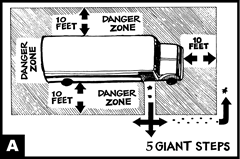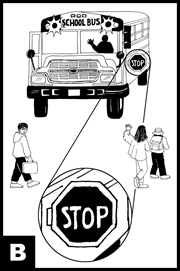School Buses are the safest way to get to school. Safety Tips from the Tennessee Department of Safety

School buses are nearly eight times safer than passenger vehicles. But children must take care when boarding or leaving the bus.
While an average of 7 school-age passengers are killed in school bus crashes each year, 19 are killed getting on and off the bus. Most of those killed are children from five to seven years old.
They are hit in the danger zone around the bus (A), either by a passing vehicle or by the school bus itself.
It is illegal for a vehicle to pass a bus with its red light flashing.
Young children are most likely to be hit because they:
- Hurry to get on or off the bus,
- Act before they think and have little experience with traffic,
- Assume motorists will see them and will wait for them to cross,
- Don’t always stay within the bus driver’s sight, or
- Drop something as they get off the bus and run into the path of the bus to pick it up.
Teach your child to get on and off the bus safely:
- When getting on the bus, stay away from the danger zone and wait for the driver’s signal. Board the bus one at a time.
- When getting off the bus, look before stepping off the bus to be sure no cars are passing on the shoulder (side of the road). Move away from the bus.
- Before crossing the street, take five “giant steps” out from the front of the bus, or until the driver’s face can be seen (A). Wait for the driver to signal that it’s safe to cross.
- Look left-right-left when coming to the edge of the bus to make sure traffic is stopped. Keep watching traffic when crossing.
Safety safety steps you can take:
- Supervise children to make sure they get to the stop on time, wait far away from the road, and avoid rough play.
- Teach your child to ask the driver for help if he/she drops something near the bus. If a child bends down to pick up something, the driver cannot see him/her and the child may be hit by the bus. Have your child use a backpack or book bag to keep loose items together.
- Make sure clothing and backpacks have no loose drawstrings or long straps, to get caught in the handrail or bus door.
- Encourage safe school bus loading and unloading.
- If you think a bus stop is in a dangerous place, talk with your school office or transportation director about changing the location.
Learn and follow school bus stop laws:
Laws exist to protect children getting on and off the bus and protect you from a tragedy. Tennessee law requires that:
 Vehicles must stop before reaching a bus that has its flashing red warning lights and/or stop signal arm extended (B). Vehicles may not pass until the flashing red lights and signals are turned off.
Vehicles must stop before reaching a bus that has its flashing red warning lights and/or stop signal arm extended (B). Vehicles may not pass until the flashing red lights and signals are turned off.- Vehicles traveling in the same and opposite direction as the bus on an undivided road are always required to stop.
- Vehicles traveling on a divided, or separated, highway do not have to stop when meeting or passing a bus on the other side of the road.
- Drivers never pass on the right side of the bus, where children enter or exit. This is illegal and can have tragic results.
Violation of these laws can result in a citation and fine. In many places, school bus drivers can report passing vehicles.
For more information, contact TDOS Pupil Transportation at 615.687.2301 or www.tn.gov/safety. Help is also available from by contacting the DOT Auto Safety Hotline at 1-888-327-4236 or www.nhtsa.dot.gov
Illustrations from Indiana University School of Medicine


